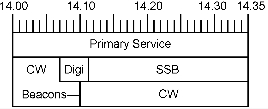20 metres
| Band: 20m | |
| Bands | |
| 160m 80m 60m 40m 30m 20m 17m 15m 12m 10m 6m 4m 2m 1.25m 70cm 33cm 23cm 3cm | |
| Band Privileges | |
| US Extra | 14.000-14.350 |
| US Advanced | 14.025-14.150 14.175-14.350 |
| US General | 14.025-14.150 14.225-14.350 |
| US Technician | None |
| UK (all) | 14.000-14.350 |
Equipment
Related wiki pages: Transceivers, Receivers, Radio/PC Interfaces
Most HF amateur transceivers support this and other commonly-used bands in the 160m - 10m range. Radios intended for SWL reception are typically able to tune these frequencies, although some will be unable to demodulate CW and SSB signals on the band due to lack of usable beat-frequency oscillators on low-end broadcast receivers.
Modulation
Related wiki pages: Modes
As with other HF bands, the lower portion of the band is CW and the remainder is primarily SSB, with some limited use of digital modes.
Propagation
Related wiki pages: Propagation
Signals on this band are often heard over great distances during daytime, when lower-frequency bands are silenced by severe D-layer absorption. Stations therefore may choose to operate on this band before sunset, then move to lower frequencies after nightfall as the lower bands are less suited to DX in daytime use.
Australian bandplan
Access: Advanced and Standard licensees only
| Bands | |
| HF and MF | 160 metres * 80 metres* 60 metres * 40 metres * 30 metres * 20 metres * 17 metres * 15 metres * 12 metres * 10 metres |
| VHF | 6 metres * 4 metres * 2 metres * 1.25 metres |
| UHF | 70 centimetres * 33 centimetres * 23 centimetres * 13 centimetres |
| Microwave | 9 centimetres * 6 centimetres * 3 centimetres * 1.25 centimetres * Bands above 24GHz |
| See also | US bandplan |
